This little girl is the only one of my ancestors, back to 1800, not born in south Ulster.
It brings to mind another little girl, her great-grandmother, who was born in India about 1794 and married 11 years later.
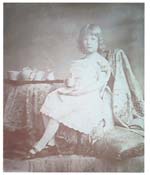
Morell of Ballybay
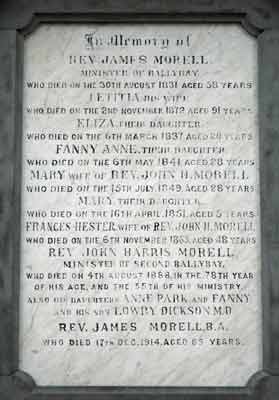
Morell Genealogy
The basic Morell genealogy can be deduced from a gravestone located directly behind 2nd Ballybay Presbyterian Church. There is a clear succession from grandfather to father to son, in which three men, Rev James Morell, Rev John Harris Morell & Rev James Morell, served in successon as ministers to this small Co Monaghan town. In total the succession lasted 115 years (for text see second Ballybay Church records).
Front Page of the Diary of James Morell A book |
However the story told by the gravestone is a significant simplification; the actual facts are more complicated and throw some light on dynamics within Presbyterianism and the Irish population in early 19th century Ulster.
Rev James Morell (1773-1831)
There is a joke that the first item on the agenda of any republican or communist meeting is a split. If true then it is a habit that was learned from the Presbyterians, who of course around the end of the eighteenth century were frequently accused by government of being ‘republicans’ and ‘democrats’. It should not therefore come as a surprise that Rev James Morell’s arrival in Ballybay in 1799 had its attendant split.
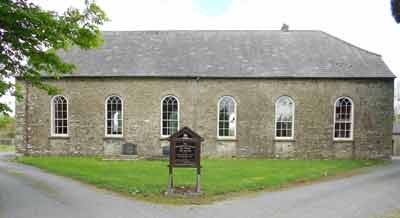
The records of the Synod of Ulster give a bare outline of the facts. It was reported on June 25th 1799 that Ballybay ‘have on second trials Mr Morell’. They also note that ‘A Supplication from a part of the Congregation of Ballybay was presented to the Synod praying that another Poll might be taken respecting Mr. Morell’. After hearing the Commissioner and the Presby. of Monaghan at some length, it was decided to dismiss the affair. At the meeting of the Synod the next year the Monaghan Presby. reported that they ordained the Revd. Jas. Morell in the Congon. of Ballybay 6th Aug. last, who is a contributor to the widows' fund.
Freemans Journal, Oct 21 1815 ACADEMY The Reverend J MORELL A. M. intends opening an ACADEMY at his House at Fairview near Ballybay on Tuesday the 7th November next. Fairview, October 2, 1815 |
Behind the formal record of the call lies a story that appears in a number of different sources. It appears that when James Morell received a call in 1799 a sizeable minority of the congregation were unhappy with the choice believing him to be a 'landlords' man'. At first they petitioned the Synod of Ulster for a second poll; this request having been refused, they then attempted to bar his entry to the meeting house.
A detailed comment of the affair is given in the Evangelical Witness;
“After Mr. Morell had received the call from Ballybay, a party in the congregation determined, if possible, to prevent his ordination, and accordingly they locked the doors and gate of the church, and he was obliged to preach in the open air in an adjoining field for nine Sabbaths. The large majority of the congregation adhered to Mr. Morell, and, after several ineffectual attempts to get peaceable possession of the church, a memorial, numerously and respectably signed, was addressed by them to the Lord Lieutenant, requesting him to aid them with a military party in regaining the use of the church. His Excellency, having learned that Mr. Morell had been ordained by the Presbytery to the pastoral charge of the congregation, enclosed an order to the captain of a troop of dragoons, then quartered in Monaghan, to put the minister into possession of the church. However, before using the power thus placed in his hands, he went on the following Sabbath to the gate of the meeting-house, accompanied by a large number of the members of the congregation, and demanded admittance, but was again refused. The late Mr. Alexander Waddell then started on a swift horse for Monaghan, distant about eight miles, and in the course of a few hours a troop of dragoons made their appearance.
The lock of the gate was broken, and the doors of the church forced open, and the opposing party having fled precipitately on the appearance of the military, Mr. Morell ascended the pulpit and conducted the services; the officer in command of the military standing on the stairs of the pulpit, and some of the soldiers mounting guard. No further opposition was attempted.
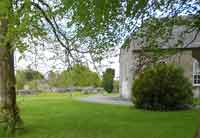
Upwards of 190 former members subsequently petitioned the Associate (Seceder) Assembly and in due course a congregation was established under the auspices of that body next door to the old church. The first minister was Robert McAuley. He was succeeded by Joseph Martin and then by David Bell, who was prominent in the Tenant Rights movement and subsequently joined the IRB. Notwithstanding this uneasy start Mr Morell's ministry appears to have flourished and at the time of his death the congregation consisted of 600 families.
Between 1814 & 1822 James Morell kept a diary which was deposited in the Presbyterian Historical Society by his great grandson, Rev John Morell McWilliam in the 1950s (see Morell diary/Manuscripts).
In 1826 Rev James Morell's brother, Hugh emigrated to New Brunswick, Canada. A series of letters to him, including two from his brothers, James & John of Balteagh, Co Derry have been preserved (see Letters)
See Obituaries of Rev James Morell, Rev John Harris Morell & Rev Charles Lucas Morell.
Morell WivesWhile only a minority of Presbyterians were directly involved in the 1798 rising, the government remained suspicious of them. Accordingly Lord Castlereagh and his secretary, Knox, planed to increase the government salary or Regium Donum paid to ministers with the Rev Robert Black, Presbyterian minister of Derry appointed as government agent. In 1810 Rev James Morell of Ballybay married Letitia Harris, granddaughter of Rev Frank Lucas an Established Church parson and son of a Monaghan landed family. 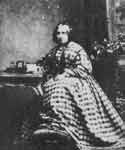 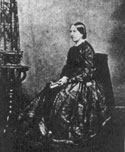 |
Rev John Harris Morell (1811-1888)
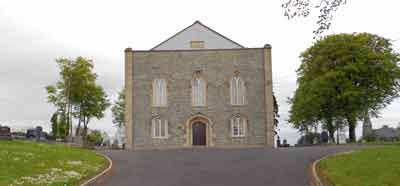
In 1831 his father died. John had just finished his theological studies and a section of the congregation considered this providential and wished to issue a call. A further section considered him too young. The net result was a split, which eventually led to the
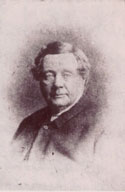
formation of 2nd Ballybay and the building of a new church more or less in the town with John as a minister. A number of things can be said about this split.
It shouldn’t be forgotten that by the time of James’ death the congregation consisted of 600 families and was probably too large for one minister. Both this split and the one involving John’s father occurred at a time of population growth which continued up till the famine. Since the time of the famine falling population numbers has forced the merging of numerous country congregations – regardless of the doctrinal or personal disputes which caused the original split.
It is reported by Jack that John’s mother, Letitia, was so angered by the proceedings that she had her husband’s body disinterred and reburied in the graveyard of the new church.
While his new church was being constructed, the young minister was forced to conduct services in a room or shed. The Ordnance Survey memoirs for Ballybay, dated 1835, state that ‘the new meeting house is still under construction but delayed because of want of funds’.
The various splits in Presbyterian congregations in the Ballybay area were symptomatic of splits within the wider Presbyterian community, often between Liberals and Evangelicals. This tension was particularly marked during the campaign for Tenant Rights after the famine. While I don't know how fervently Evangelical John was, he would appear to have embraced a conservative view of property from his mother, Letitia Harris, who was descended from a landed gentry family. The tensions in this period (particularly between Rev Morell and his brother-in-law, Rev Thomas McWilliams) are described in an Article I wrote for the Creggan Historical Society.
Rev James Morell (1849-1914)
No such drama attended the installation of Rev James Morell in succession to his father. When the latter retired after 50 years in the ministry James was already minister in Rathfriland and I have heard no hints of any objection to his call. His death in 1914 brought to an end 115 unbroken years of service by the family to Presbyterians in the town although some of the congregation wanted to issue a call to Rev John Morell McWilliam, grandson of John & nephew of James, who was working as a minister in Scotland at the time. He declined!
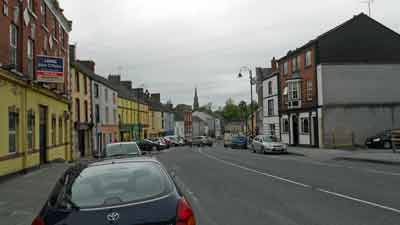
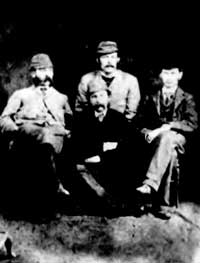
The relationship between the Morells and the McWilliams was complicated.
Rev Thomas McWilliams married Anna Russell; Rev John Morell married her sister, Mary. William (left) & Thomas (front) were children of the former; James (back) of the latter marriages. Mary Morell died in 1849 and John Morell then married Hester Dickson (above). William married Hessie, a daugher of John & Hester. Lowry (right) was Hessie's brother.
My father, a solicitor in Monaghan, also had an office in Ballybay. When the family left Monaghan in 1970 he closed the practice in Monaghan but retained his connection with Ballybay till his death in 1989. The family can thus claim a 190 year connection with this town.
OS memoir comment on the construction of 2nd Ballybay, Oct 1835
A new meeting house of very large dimensions is at present in progress at the west side of the town. The walls are built and roof nearly completed. It is estimated to accommodate between 800 & 900 persons at worship. The funds are raised by subscription and the building is under the management of a committee of subscribers who have difficulty in obtaining the necessary amount, in consequence of which the work is delayed.
OS Memoir note on the main street of Ballybay
In the town there are not more than 8 tolerably good houses. The remainder are very poor. The street is very dirty and is neither lighted nor paved. The inhabitants of the town of Ballybay may be divided into three classes, viz, shopkeepers, tradesmen and labourers.
Links to main Family Index / Murrell of Balteagh / Harris of Mullendavagh / Dickson of Ballyshannon / McWilliam of Monaghan
Back to Top